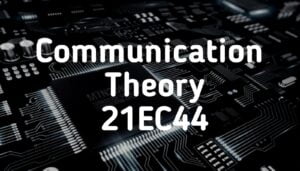
Communication Theory 21EC44
Module 1`
AMPLITUDE MODULATION: Introduction, Amplitude Modulation: Time & Frequency Domain description, Switching modulator, Envelop detector. DOUBLE SIDE BAND-SUPPRESSED CARRIER MODULATION: Time and Frequency Domain description, Ring modulator, Coherent detection, Costas Receiver, Quadrature Carrier Multiplexing. SINGLE SIDE–BAND AND VESTIGIAL SIDEBAND METHODS OF MODULATION: SSB Modulation, VSB Modulation, Frequency Translation, Frequency Division Multiplexing, Theme Example: VSB Transmission of Analog and Digital Television.
Module 2
ANGLE MODULATION: Basic definitions, Frequency Modulation: Narrow Band FM, Wide Band FM,
Transmission bandwidth of FM Signals, Generation of FM Signals, Demodulation of FM Signals, FM Stereo
Multiplexing, Phase–Locked Loop: Nonlinear model of PLL, Linear model of PLL, Nonlinear Effects in FM
Systems. The Superheterodyne Receiver
Module 3
NOISE: Shot Noise, Thermal noise, White Noise, Noise Equivalent Bandwidth. NOISE IN ANALOG MODULATION: Introduction, Receiver Model, Noise in DSB-SC receivers. Noise in AM receivers, Threshold effect, Noise in FM receivers, Capture effect, FM threshold effect, FM threshold reduction, Preemphasis and De-emphasis in FM
Module 4
SAMPLING AND QUANTIZATION: Introduction, Why Digitize Analog Sources? The Low pass Sampling process Pulse Amplitude Modulation. Time Division Multiplexing, Pulse-Position Modulation, Generation of PPM Waves, Detection of PPM Waves
Module 5
SAMPLING AND QUANTIZATION (Contd): The Quantization Random Process, Quantization Noise, Pulse–Code Modulation: Sampling, Quantization, Encoding, Regeneration, Decoding, Filtering, Multiplexing; Delta Modulation , Application examples – (a) Video + MPEG (Text1:7.11) and (b) Vocoders